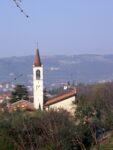 Nestled in the lush Valpantena valley five miles east of downtown Verona in the village of Santa Maria in Stelle is the little parish church of Santa Maria Assunta. Underneath it is a unique archaeological site, a Roman aqueduct turned nymphaeum turned early Christian baptismal font turned extravagantly frescoed church and pilgrimage destination. The hypogeum is named Santa Maria in Stelle after the starry sky fresco on the ceiling, and the whole village is named after its greatest archaeological gem.
Nestled in the lush Valpantena valley five miles east of downtown Verona in the village of Santa Maria in Stelle is the little parish church of Santa Maria Assunta. Underneath it is a unique archaeological site, a Roman aqueduct turned nymphaeum turned early Christian baptismal font turned extravagantly frescoed church and pilgrimage destination. The hypogeum is named Santa Maria in Stelle after the starry sky fresco on the ceiling, and the whole village is named after its greatest archaeological gem.
The hypogeum was first constructed in the 1st century as an aqueduct to channel the water of a natural spring on the property to supply fresh water to the villa and agricultural estates of the Gens Pomponia, an important Roman senatorial family who owned large tracts of land in the area. It’s one of few examples of Roman aqueducts in northern Italy, and the best conserved. There is still water running through the original conduits, albeit with nothing like the powerful flow they channeled in the days of Roman yore.
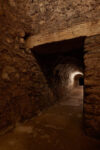 In the first half of the 3rd century, a nymphaeum, a cult site dedicated to nymphs, was added to the aqueduct by expanding one of its cisterns. An inscription at the entrance to the hypogeum records that Publius Pomponius Cornelianus built it and lists the rest of his family: wife Julia Magia, sons Pomponius Julianus (future praetor of Arabia) and Pomponius Magianus (future praetor of Thrace). The inscription is not in its original context, so it’s not clear whether what he built in this case refers to the nymphaeum or another structure, but we know from other inscriptions that Cornelianus, a prominent imperial magistrate and major landowner, dedicated a votive altar “to the nymphs and their waters” for the restoration of a nearby mineral spring around between 200 and 215 A.D.
In the first half of the 3rd century, a nymphaeum, a cult site dedicated to nymphs, was added to the aqueduct by expanding one of its cisterns. An inscription at the entrance to the hypogeum records that Publius Pomponius Cornelianus built it and lists the rest of his family: wife Julia Magia, sons Pomponius Julianus (future praetor of Arabia) and Pomponius Magianus (future praetor of Thrace). The inscription is not in its original context, so it’s not clear whether what he built in this case refers to the nymphaeum or another structure, but we know from other inscriptions that Cornelianus, a prominent imperial magistrate and major landowner, dedicated a votive altar “to the nymphs and their waters” for the restoration of a nearby mineral spring around between 200 and 215 A.D.
 Sometime in the 4th century, probably after a visit from Saint Zeno, Bishop of Verona, the nymphaeum was converted to use as a baptismal font. Some remains of the elliptical tub used for baptisms are extant in the atrium of the ancient nymphaeum, and frescoes were added to the walls with motifs related to salvation, initiation and martyrdom decorated with floral and swirls. The murals are worn with large missing sections, but two can be recognized as depictions of Daniel in the lion’s den, complete with a tiny Habakkuk above him to his left bringing mystical food and drink, and Christ the Lawgiver flanked by Peter and Paul. A partial view of the horses in a quadriga also survives, its interpretation unclear. These are the only Paleo-Christian frescoes in northern Italy.
Sometime in the 4th century, probably after a visit from Saint Zeno, Bishop of Verona, the nymphaeum was converted to use as a baptismal font. Some remains of the elliptical tub used for baptisms are extant in the atrium of the ancient nymphaeum, and frescoes were added to the walls with motifs related to salvation, initiation and martyrdom decorated with floral and swirls. The murals are worn with large missing sections, but two can be recognized as depictions of Daniel in the lion’s den, complete with a tiny Habakkuk above him to his left bringing mystical food and drink, and Christ the Lawgiver flanked by Peter and Paul. A partial view of the horses in a quadriga also survives, its interpretation unclear. These are the only Paleo-Christian frescoes in northern Italy.
Around the turn of the 5th century the baptismal space was expanded and two semi-elliptical chambers added to the left and right of the atrium. It became a space dedicated to the teaching of the catechism and the walls and ceilings were frescoed with scenes and figures from the Old and New Testament. The north chamber’s frescoes are the most spectacular. They were painted in the 5th century by an unusually fine artist for such a modest site, with highly refined renderings of faces, clothing, architecture and dynamic action. Even the border, a three-dimensional Greek meander pattern, seems to leap off the wall (and sink deep into it).
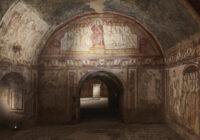 On either side of the entrance to the north camber are two youths carrying torches, iconography often found at the entrance to Roman villas. Above the entrance and the youths is an Enthroned Christ with a rare blue halo. Very Roman-looking unbearded apostles in togas flank him. Two cylindrical boxes on each end of the apostles contain scrolls of the New and Old Testament. Jesus and the apostles also hold scrolls. This fresco dates to the 6th century.
On either side of the entrance to the north camber are two youths carrying torches, iconography often found at the entrance to Roman villas. Above the entrance and the youths is an Enthroned Christ with a rare blue halo. Very Roman-looking unbearded apostles in togas flank him. Two cylindrical boxes on each end of the apostles contain scrolls of the New and Old Testament. Jesus and the apostles also hold scrolls. This fresco dates to the 6th century.
Turning left, the first panel depicts the entry of Christ into Jerusalem as people lay down rugs for him, an event described in the Gospel of Luke. The next scene is from the Book of Daniel and features Shadrach, Meshach, and Abednego refusing to worship the gold idol of King Nebuchadnezzar II. The motif continues in the next fresco where the three stand in the fiery furnace, protected from harm by the angel behind them.
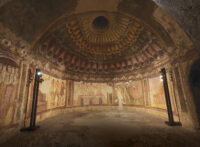 Then it’s back to the New Testament with a shockingly dynamic Massacre of the Innocents from the Gospel of Matthew. Herod is on the right commanding two soldiers who are in the act of slamming babies to death. Another child bleeds on the ground. The Nativity is next, but it lacks the iconography we’re familiar with. Instead of Mary and Joseph adoring Christ in the manger with shepherds and animals, only the animals are present: an ox and a donkey. The manger has faded and only the outline of the head of Baby Jesus is still visible. This very simple scene of Christ Child and animals was the earliest representation of the Nativity. Mary and Joseph and the rest of the cast were introduced to the iconography in later centuries.
Then it’s back to the New Testament with a shockingly dynamic Massacre of the Innocents from the Gospel of Matthew. Herod is on the right commanding two soldiers who are in the act of slamming babies to death. Another child bleeds on the ground. The Nativity is next, but it lacks the iconography we’re familiar with. Instead of Mary and Joseph adoring Christ in the manger with shepherds and animals, only the animals are present: an ox and a donkey. The manger has faded and only the outline of the head of Baby Jesus is still visible. This very simple scene of Christ Child and animals was the earliest representation of the Nativity. Mary and Joseph and the rest of the cast were introduced to the iconography in later centuries.
Next to the Nativity is an elliptical niche. Two figures of women in exotic clothing adorn opposing walls of the entry archway. The back wall of the niche has solar image on the back wall with an umbrella on the curved ceiling. Above the entry to the niche is a very worn figure of Mary. On the ceiling above her is a dark blue background with white stars. This is the fresco that gives the hypogeum its name. It dates to the 9th century.
 Last but most certainly not least, and the main motivation for this entire post, is a fresco like nothing I’ve ever seen before decorating the domed ceiling of the chamber. It’s a series of tubes, four rows of them, each in a different color — red on the bottom, then blue, yellow and green. Every tube is decorated. This incredibly abstract vista is likely an architectural reference. Romans used “tubuli,” empty clay pipes, in domes to fill the space while lightening the weight pressing down on the support walls. The artist has brought the structural secrets of a dome to the surface.
Last but most certainly not least, and the main motivation for this entire post, is a fresco like nothing I’ve ever seen before decorating the domed ceiling of the chamber. It’s a series of tubes, four rows of them, each in a different color — red on the bottom, then blue, yellow and green. Every tube is decorated. This incredibly abstract vista is likely an architectural reference. Romans used “tubuli,” empty clay pipes, in domes to fill the space while lightening the weight pressing down on the support walls. The artist has brought the structural secrets of a dome to the surface.
The south chamber is smaller with less elaborate decoration. Its frescoes date to the 8th century and are very damaged. There is a youth holding a scroll and a panel of the hand of god with devotional inscriptions on either side. A 1st century funerary altar not original to the space has been placed in the chamber. It was toppled and had an inscription carved into the back by Pope Urban III in the 12th century.
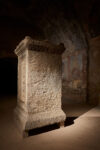 The hypogeum was used in the 8th and 9th centuries as a safe place for Christians to meet when the Lombards were in charge, and it was ready to step in for parish services in 1100 when the church above it was severely damaged in an earthquake. In 1187, Pope Urban III declared any pilgrims visiting the site would receive plenary indulgences. He used that ancient altar for the dedication to signify the triumph of Christianity over paganism. The hypogeum was used mostly as a well in the late Middle Ages, but saw a revival of its religious significance in the late 16th century. It was consecrated for mass by the Bishop of Verona in the 18th century.
The hypogeum was used in the 8th and 9th centuries as a safe place for Christians to meet when the Lombards were in charge, and it was ready to step in for parish services in 1100 when the church above it was severely damaged in an earthquake. In 1187, Pope Urban III declared any pilgrims visiting the site would receive plenary indulgences. He used that ancient altar for the dedication to signify the triumph of Christianity over paganism. The hypogeum was used mostly as a well in the late Middle Ages, but saw a revival of its religious significance in the late 16th century. It was consecrated for mass by the Bishop of Verona in the 18th century.
The hypogeum was closed to the public in 2008 due to its precarious condition. The frescoes were afflicted with thick mineral deposits and biological growth. Water penetration from the church above had led to paint loss, and materials used in a misguided restoration attempt in the 1960s had also deteriorated. In 2016, a new program of conservation, documentation and light design restored the murals and the space was opened to visitors again on a very limited basis to maintain a stable temperature and humidity in the delicate environment. The restoration of the north chamber was particularly successful, as the removal of deposits revealed the colors of the frescoes were still brilliant.
Take a virtual tour of the amazing north chamber in this photogrammetric reconstruction.